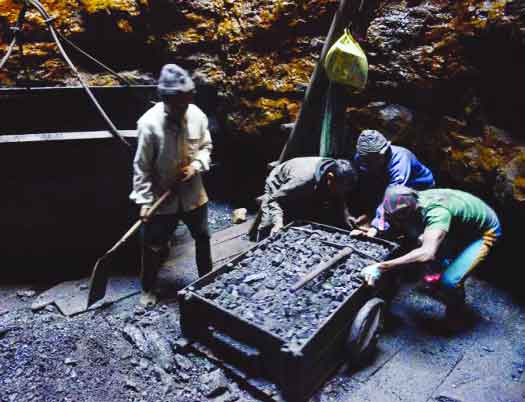It is unfortunate that Meghalaya, which is one of the most uranium-rich States, remains untapped because of opposition from locals despite clearances by UCIL. Yet coal mafia flourishes. Narrow interests must not hold energy needs to ransom
Agnes Kharshiing and Amita Sangma, two well-known environmentalists from Meghalaya, were brutally attacked last year by a group of 30-40 people, suspected to be members of the coal mining mafia in Meghalaya’s East Jaintia Hills district. Reports of illegal rat-hole coal mining being carried out in defiance of a ban imposed by the National Green Tribunal (NGT) had taken them to the area for an on-the-spot verification.
Even as the two activists were recovering from injuries, an accident that trapped 15 coal miners in the rat-hole mine was reported from that very area. While there has been very little progress in the rescue operations, the factum of illegal mining being carried out in sub-human conditions stood fully exposed.
While imposing the ban some four years ago, the NGT had taken into consideration unsafe mining practices along with other environmental concerns. For instance, earlier reports had pointed out that mining activities directly impact water quality of the region and its colour changes completely. Later, as a relaxation to the complete ban, the already extracted coal lying at the pit heads was allowed to be transported. However, over a period of time, this virtually became an excuse for a continuing and never-ending stream of illegal activities. It is, therefore, important that the matter is taken up afresh to put an end to the farce of transportation of the extracted coal. Besides stringent regulations must be framed and implemented for maintenance of safety and preservation of environment.
Admittedly, coal mining is a very important contributor to the economy of the small State. And for some political parties, the lifting of the NGT ban on mining became a top agenda. But this is in complete contrast with the prevailing situation in the neighbouring district of Nongstoin, where the Kyelleng-Pyndengsohiong, Mawtahbah uranium project (KPM uranium project) by the Uranium Corporation of India Ltd (UCIL) has been lying in a limbo for over a decade.
Despite receiving all the necessary clearances, including those from the Ministry of Environment, Forest and Climate Change, after a public hearing at Nongbah Jynrin, the project has failed to take off. This due to stiff opposition from a section of local tribals as well as the Khasi Students’ Union (KSU).
The UCIL, on its part, seems to have undertaken extensive awareness campaigns to counter the motivated disinformation. Diverse groups of people — consisting of NGOs, legislators, Khasi Students’ Union and media persons — have been taken to the project site by UCIL to observe its operations at Jaduguda in Jharkhand in order to convince them of the safety. Similarly, in the past, several teams of medical experts, even from the All India Institute of Medical Sciences (AIIMS), New Delhi, have visited Nongstoin, Pambriew and adjoining areas. They found nothing abnormal about the general health of the people in the vicinity of the mines, particularly new-borns.
Thus, on the one hand, we have a set of mining activities, which continue in defiance of court orders, and on the other, we have the much-needed uranium, whose mining remains obstructed. A recent parliamentary panel report recommended that necessary steps be undertaken for the opening up of new mines to reduce India’s dependence on imported uranium. Currently, India imports this precious raw material from Canada, Russia and Kazakhastan.
According to estimates, there are reserves of over 20,000 tonnes of high-grade uranium ore in Domiasiat, Wahkyn and Wahkut besides other areas of Nongstoin. Most of our requirement, to create reserves of uranium for production of atomic energy, could, thus, be met from the resources available in Meghalaya.
In this context, some Constitutional issues also need focussed attention. According to the Union List (Schedule VII) entry 6, atomic energy and mineral resources necessary for its production are in the domain of the Union Government. The entries 54 and 55 pertain to mining regulations in general besides their safety aspects.
At the same time, Autonomous District Councils have also been empowered through Schedule VI of the Constitution on certain related matters. As per Section 12A (b) of Schedule VI, the President may, with respect to any Act of Parliament, by notification, direct that it shall not apply to an autonomous district or an autonomous region in the State of Meghalaya, or with such exceptions or modifications… et al. This provision of Schedule VI needs to be interpreted in unambiguous terms so that narrow local interests are not able to hold to ransom issues of vital national importance.
(The writer is a retired Delhi Police Commissioner and former Governor of Meghalaya)


























